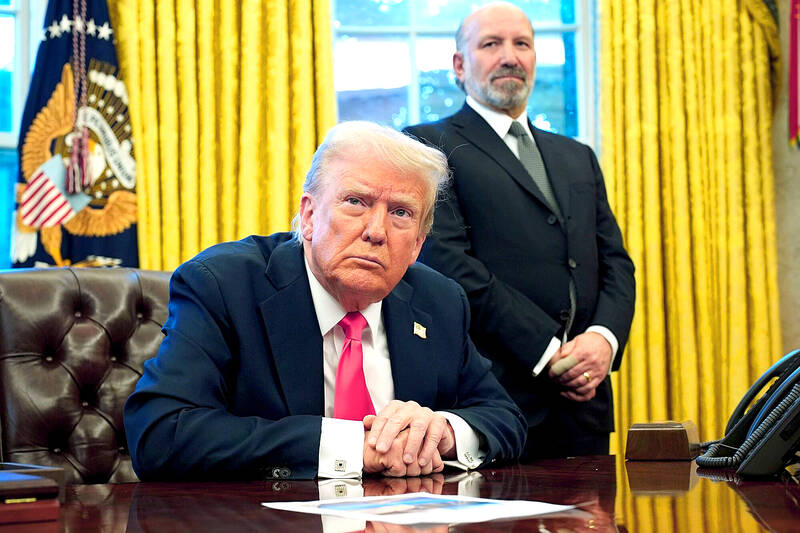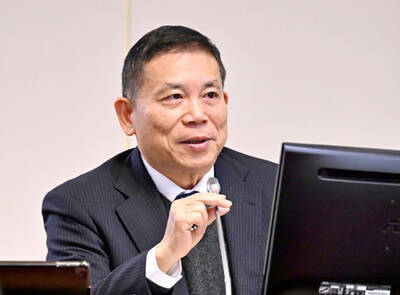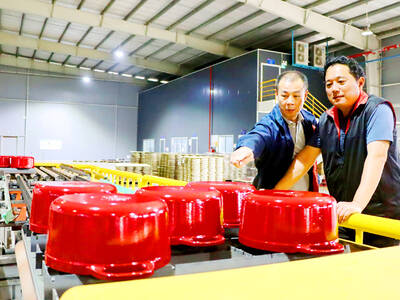US President Donald Trump has signed an executive order directing the US Department of Commerce to examine possible copper tariffs, the latest in a string of measures aimed at imposing sector-specific levies that could reshape global supply chains.
Trump said the order would have a “big impact” as he signed it in the Oval Office, joined by US Secretary of Commerce Howard Lutnick.
Senior administration officials earlier on Tuesday cast the step as necessary to address what they said was a national security issue. They argued that dumping and overcapacity in world markets had impacted domestic US copper production, leaving weapons systems and other critical products dependent on imports.

Photo: Abaca/Bloomberg
The officials, briefing reporters on condition of anonymity, said it was premature to discuss a potential rate for the tariffs.
Copper is a critical material for modern economies because of its widespread use in the wiring that delivers electricity to homes and factories. Many analysts forecast higher prices this decade, as supply fails to keep pace with demand. As with other metals, China’s grip is particularly strong when it comes to processing — the country accounted for about 44 percent of the world’s refined copper last year, according to the US Geological Survey.
The investigation would be carried out under Section 232 of the Trade Expansion Act, which gives the US president broad authority to impose trade restrictions on domestic security grounds.
Trump is also employing that authority to impose 25 percent tariffs on two other industrial metals — steel and aluminum — with those levies slated to take effect next month.
Lutnick said in a statement that the action would also probe products that include copper, and said the administration aimed to rejuvenate the domestic copper industry.
“Like our steel and aluminum industries, our great American copper industry has been decimated by global actors attacking our domestic production,” Lutnick said. “Tariffs can help build back our copper industry, if necessary, and strengthen our national defense.”
Peter Navarro, a Trump trade adviser, singled out China, saying it had “long used industrial overcapacity and dumping as an economic weapon to dominate global markets, systematically undercutting competitors and driving rival industries out of business.”
The US consumed about 1.6 million tonnes of refined copper last year, according to the US Geological Survey.
While the US has significant mines, producing about 850,000 tonnes of primary copper last year, it still relies on imports from key trade allies to fill the need.
Chile is the largest import source, accounting for 38 percent of total import volumes, followed by Canada and Mexico at 28 percent and 8 percent respectively.

UNCERTAINTY: Innolux activated a stringent supply chain management mechanism, as it did during the COVID-19 pandemic, to ensure optimal inventory levels for customers Flat-panel display makers AUO Corp (友達) and Innolux Corp (群創) yesterday said that about 12 to 20 percent of their display business is at risk of potential US tariffs and that they would relocate production or shipment destinations to mitigate the levies’ effects. US tariffs would have a direct impact of US$200 million on AUO’s revenue, company chairman Paul Peng (彭雙浪) told reporters on the sidelines of the Touch Taiwan trade show in Taipei yesterday. That would make up about 12 percent of the company’s overall revenue. To cope with the tariff uncertainty, AUO plans to allocate its production to manufacturing facilities in

Taiwan will prioritize the development of silicon photonics by taking advantage of its strength in the semiconductor industry to build another shield to protect the local economy, National Development Council (NDC) Minister Paul Liu (劉鏡清) said yesterday. Speaking at a meeting of the legislature’s Economics Committee, Liu said Taiwan already has the artificial intelligence (AI) industry as a shield, after the semiconductor industry, to safeguard the country, and is looking at new unique fields to build more economic shields. While Taiwan will further strengthen its existing shields, over the longer term, the country is determined to focus on such potential segments as

TAKING STOCK: A Taiwanese cookware firm in Vietnam urged customers to assess inventory or place orders early so shipments can reach the US while tariffs are paused Taiwanese businesses in Vietnam are exploring alternatives after the White House imposed a 46 percent import duty on Vietnamese goods, following US President Donald Trump’s announcement of “reciprocal” tariffs on the US’ trading partners. Lo Shih-liang (羅世良), chairman of Brico Industry Co (裕茂工業), a Taiwanese company that manufactures cast iron cookware and stove components in Vietnam, said that more than 40 percent of his business was tied to the US market, describing the constant US policy shifts as an emotional roller coaster. “I work during the day and stay up all night watching the news. I’ve been following US news until 3am

COLLABORATION: Given Taiwan’s key position in global supply chains, the US firm is discussing strategies with local partners and clients to deal with global uncertainties Advanced Micro Devices Inc (AMD) yesterday said it is meeting with local ecosystem partners, including Taiwan Semiconductor Manufacturing Co (TSMC, 台積電), to discuss strategies, including long-term manufacturing, to navigate uncertainties such as US tariffs, as Taiwan occupies an important position in global supply chains. AMD chief executive officer Lisa Su (蘇姿丰) told reporters that Taiwan is an important part of the chip designer’s ecosystem and she is discussing with partners and customers in Taiwan to forge strong collaborations on different areas during this critical period. AMD has just become the first artificial-intelligence (AI) server chip customer of TSMC to utilize its advanced